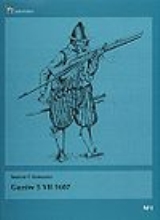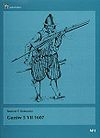
Battle of Guzów
Encyclopedia
The Battle
of Guzów took place on July 6, 1607, at the village of Guzów in Szydłowiec County, Polish-Lithuanian Commonwealth
. The confrontation was between the forces of the Zebrzydowski Rebellion (10,000 infantry
and 600 cavalry
under Mikołaj Zebrzydowski and Janusz Radziwiłł) against the Royalists supporting King Sigismund III Vasa
(9,100 infantry, 3,200 cavalry, and 24 cannon
), under the command of Polish Grand Crown Hetman
(commander-in-chief) Stanisław Żółkiewski and the Lithuanian Hetman
Jan Karol Chodkiewicz
.
The "Zebrzydowski rebellion" was waged by a large number of Polish-Lithuanian nobles (szlachta
) who had many grievances against the King; who, as a Swede, concerned himself regaining his Swedish throne. The Royal Army was originally sent to pacify the rebels. However, a full-scale battle ensued in the village, with 200 casualties, and it ended with the Royalists routing the rebellious factions.

During the next twelve months new "insurrections" burst forth all over the country; and peace was only last resorted by the proclamation (1609) of a general amnesty, which punished nobody and decided nothing. The growing unwillingness of the Grand Hetman Żółkiewski "to shed the blood of our brethren" was the cause of this unsatisfactory solution. The helpless King was obliged to concur, and henceforth abandoned all his projects of constitutional reform.
, the opposition leader Jan Rokita
, who was expected to win the September 25, 2005 Polish elections, said:
In other words, the Battle of Guzów has to be repeated with the current government of President Lech Kaczyński
defeating the opposition. The government will not accept that their position is wrong. However, in the long run, some of them will wise up and concede when none of their conservative plans are implemented.
Battle
Generally, a battle is a conceptual component in the hierarchy of combat in warfare between two or more armed forces, or combatants. In a battle, each combatant will seek to defeat the others, with defeat determined by the conditions of a military campaign...
of Guzów took place on July 6, 1607, at the village of Guzów in Szydłowiec County, Polish-Lithuanian Commonwealth
Polish-Lithuanian Commonwealth
The Polish–Lithuanian Commonwealth was a dualistic state of Poland and Lithuania ruled by a common monarch. It was the largest and one of the most populous countries of 16th- and 17th‑century Europe with some and a multi-ethnic population of 11 million at its peak in the early 17th century...
. The confrontation was between the forces of the Zebrzydowski Rebellion (10,000 infantry
Infantry
Infantrymen are soldiers who are specifically trained for the role of fighting on foot to engage the enemy face to face and have historically borne the brunt of the casualties of combat in wars. As the oldest branch of combat arms, they are the backbone of armies...
and 600 cavalry
Cavalry
Cavalry or horsemen were soldiers or warriors who fought mounted on horseback. Cavalry were historically the third oldest and the most mobile of the combat arms...
under Mikołaj Zebrzydowski and Janusz Radziwiłł) against the Royalists supporting King Sigismund III Vasa
Sigismund III Vasa
Sigismund III Vasa was King of Poland and Grand Duke of Lithuania, a monarch of the united Polish–Lithuanian Commonwealth from 1587 to 1632, and King of Sweden from 1592 until he was deposed in 1599...
(9,100 infantry, 3,200 cavalry, and 24 cannon
Cannon
A cannon is any piece of artillery that uses gunpowder or other usually explosive-based propellents to launch a projectile. Cannon vary in caliber, range, mobility, rate of fire, angle of fire, and firepower; different forms of cannon combine and balance these attributes in varying degrees,...
), under the command of Polish Grand Crown Hetman
Hetmans of Polish-Lithuanian Commonwealth
Hetmans of the Polish–Lithuanian Commonwealth were the highest-ranking military officers, second only to the King, in the Polish–Lithuanian Commonwealth. The first Polish title of Grand Crown Hetman was created in 1505. The title of hetman was given to the leader of Polish Army and till 1581 it was...
(commander-in-chief) Stanisław Żółkiewski and the Lithuanian Hetman
Hetmans of Polish-Lithuanian Commonwealth
Hetmans of the Polish–Lithuanian Commonwealth were the highest-ranking military officers, second only to the King, in the Polish–Lithuanian Commonwealth. The first Polish title of Grand Crown Hetman was created in 1505. The title of hetman was given to the leader of Polish Army and till 1581 it was...
Jan Karol Chodkiewicz
Jan Karol Chodkiewicz
Jan Karol Chodkiewicz was a famous Lithuanian military commander and one of the most prominent noblemen of the Polish-Lithuanian Commonwealth.-Biography:...
.
The "Zebrzydowski rebellion" was waged by a large number of Polish-Lithuanian nobles (szlachta
Szlachta
The szlachta was a legally privileged noble class with origins in the Kingdom of Poland. It gained considerable institutional privileges during the 1333-1370 reign of Casimir the Great. In 1413, following a series of tentative personal unions between the Grand Duchy of Lithuania and the Kingdom of...
) who had many grievances against the King; who, as a Swede, concerned himself regaining his Swedish throne. The Royal Army was originally sent to pacify the rebels. However, a full-scale battle ensued in the village, with 200 casualties, and it ended with the Royalists routing the rebellious factions.

During the next twelve months new "insurrections" burst forth all over the country; and peace was only last resorted by the proclamation (1609) of a general amnesty, which punished nobody and decided nothing. The growing unwillingness of the Grand Hetman Żółkiewski "to shed the blood of our brethren" was the cause of this unsatisfactory solution. The helpless King was obliged to concur, and henceforth abandoned all his projects of constitutional reform.
2007 mention
A Polish politician resurrected this battle after 400 years. In a newspaper interview on March 16, 2007 with RzeczpospolitaRzeczpospolita (newspaper)
Rzeczpospolita is a Polish national daily newspaper, with a circulation around of 160,000. Issued every day except Sunday. Rzeczpospolita was printed in broadsheet format, then switched to compact at October 16, 2007...
, the opposition leader Jan Rokita
Jan Rokita
Jan Rokita is a Polish conservative politician, a member of the Sejm, the lower chamber of the Polish parliament. He was chairman of the parliamentary club of Platforma Obywatelska from 2003 to 2005....
, who was expected to win the September 25, 2005 Polish elections, said:
In other words, the Battle of Guzów has to be repeated with the current government of President Lech Kaczyński
Lech Kaczynski
Lech Aleksander Kaczyński was Polish lawyer and politician who served as the President of Poland from 2005 until 2010 and as Mayor of Warsaw from 2002 until 22 December 2005. Before he became a president, he was also a member of the party Prawo i Sprawiedliwość...
defeating the opposition. The government will not accept that their position is wrong. However, in the long run, some of them will wise up and concede when none of their conservative plans are implemented.

